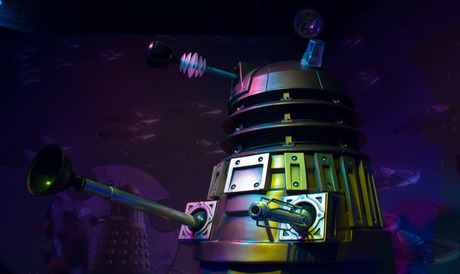Exterminating antibiotic resistance

A British citizen science project has found a possible new source of antibiotics in the most unlikely of places — a ‘Dalek’ prop from science-fiction program Doctor Who.
With antibiotic resistance one of the biggest threats facing humanity, it is vital that we come up with a solution. With this in mind, Dr Adam Roberts of University College London (UCL) created Swab and Send — a crowdfunding scheme that gives citizen scientists the chance to participate in the search for new antibiotics.
Contributors were sent a pack of swabs that they could use around their homes, their offices or any other weird and wonderful places that took their fancy. The swabs were then sent back to the UCL Eastman Dental Institute, where microbiologists would determine if there was any bacteria present on the swab that had the ability to kill other bacteria. If they did, the scientists would investigate further to see if these bacteria were producing a new antibiotic.
When Swab and Send was featured on a special episode of BBC Radio 4’s Inside Science, the program’s host, Adam Rutherford, went about swabbing various parts of BBC Broadcasting House. Beginning with his own microphone, he moved around the office, along the way taking swabs from the set of the Today program, the kitchen sponge and the revolving entryway doormat. Finally, he swabbed the eyestalk of BBC Broadcasting House’s Dalek prop — the plunger-wielding, exterminating, pepperpot-shaped enemy of the time-travelling alien known as ‘the Doctor’.
Some time later, when Rutherford visited Dr Roberts’ lab, he was presented with two different agar plates: one control plate and one which had been pre-inoculated with a Micrococcus indicator strain. The control plate showed all the different bacteria featured on the swabs, while the second plate showed whether these bacteria could kill or prevent the growth of the indicator strain, as demonstrated via a circular zone of clearing around the bacterial colonies.
While there was nothing notable about the more conventional items that Rutherford had swabbed, the Dalek was a different matter altogether, with the control plate indicating that the Dalek swab featured 12 different genera of bacteria.
The more exciting results were on the second plate, where there were clear spots around four of the colonies — all from the Dalek. As stated by Dr Roberts, “We’ve got at least three different types of bacteria from the Dalek which were able to ‘exterminate’ our Micrococcus indicator strain.”
(Ironically, said Rutherford, the Dalek is probably home to so much interesting bacteria due to the fact that so many visitors to the BBC want to touch it — despite the large sign which says ‘Please do not touch the Dalek’.)
The next stage for Dr Roberts and his colleagues is to take the Dalek bacteria and analyse it against alternative indicator strains which are more hardy than the weedy Micrococcus, such as a strain of E. coli which is resistant to about 14 or 15 different antibiotics already.
“That’s exactly the type of bacteria we want to be able to kill with new antibiotics,” Dr Roberts said. “So we would screen these against that as well. If they kill that one, then we would probably take it a little bit further in our research and try and identify the molecules responsible for the zones of inhibition that you can see on the plates.”
With the team having already identified a variety of swabbed bacteria which can kill the indicator strain — 20 of which can also kill the multidrug-resistant E. coli — there is a very real possibility that the Dalek could serve as the saviour of the human race. A bit ironic for a creature that normally wants to exterminate every living being in existence!
Mini lung organoids could help test new treatments
Scientists have developed a simple method for automated the manufacturing of lung organoids...
Clogged 'drains' in the brain an early sign of Alzheimer’s
'Drains' in the brain, responsible for clearing toxic waste in the organ, tend to get...
World's oldest known RNA extracted from woolly mammoth
The RNA sequences are understood to be the oldest ever recovered, coming from mammoth tissue...





